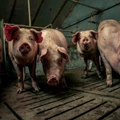
Starting a pig farm is a challenge, but if done well, it can provide farmers with happiness and a good profit. Pig farming is simple and a terrific method to get a sizable profit quickly. If you're not careful, you could make several typical blunders that will make rearing a pig more challenging.
Let's look at some typical pig farming mistakes below.
Inadequate Fencing
One of the most intelligent animals you can grow is a pig. If the fencing is inadequate, they will not only learn how to do it, but they will also remember how they did it so they can demonstrate it to others and teach them how to do it as well. To keep the fences closed, you must purchase specific hog fences. You have two options: either use hog panels, which have broad apertures at the top and bottom, or set up a three-strand electrical system. Whatever option you use, make sure to train your pigs right away and use sturdy fence materials.
Not Providing Adequate Shelter
To protect pigs from the outer elements, prevent disease, manage parasites, and conserve labor, appropriate housing and equipment are crucial. You do not need a huge barn to provide shelter for your pigs. A three-sided building with a roof is a fantastic refuge from the weather if you are rearing pigs for a few months before taking them to the butcher.
Bear in mind that you also need some areas with shade because pigs cannot perspire and will become quite hot. They can cool themselves in a wallow, but if they have pale skin, they risk sunburn. Again, your shelter need not be elaborate. A pellet construction will also work (although bear in mind that if you don't, your pigs will ultimately become curious and eventually destroy it).
Restricted Feeding and Watering
A fair rule of thumb is that you need seven pounds of food to feed a pig that weighs thirty pounds. To maintain a good pig farm, you need to put a lot of effort into making sure the pigs have good feed and proper feeding intervals.
Nearly 70% of the expense of growing pigs to maturity is spent on feeding. Finding a different source of feed that is both good quality and affordable is crucial if you want to turn any kind of profit. Farmers have to learn how to mix their feed and locate a less expensive supply of carbohydrates. If you work as a farmer full-time, you can collect any of the following to feed your pigs. Any of these can also be combined with ready-to-eat food.
Even letting your pigs go free might be beneficial in some cases, but you'll also need to discover alternate strategies for providing them with a nutritious diet. Remember, it matters what you feed your pigs.
Give them too little room
Pigs like to defecate in particular spots in their yard, which makes it much simpler to clean up after them. However, as soon as you put your pigs in a pen, you'll notice that they begin to smell. Give your pigs as much room to wander as you can and keep them as far away from your home as you can (this will also help with fly issues). Giving pigs ample amount of space helps in the reduction of diseases. Since they will not stick to their waste all day so the chances of catching an infection lessen.
Choosing a Wrong Breed
The secret to success is picking the right breed and feeding to optimize genetic potential. First, select a pig that, in terms of age and maturity, corresponds to your desired show objectives. The appropriate breed selection is crucial for a profitable pig farming enterprise. Therefore, pick the Wely race. Pick breeds that are widely accessible in your area. Native breeds are excellent choices, although their yields will be smaller. Ask for advice while selecting the right breed for your company from some of the current farmers in your area.
Deal With Your Piglets
If you run a farrow-to-finish pig farm, you need to take good care of your piglets because it is one thing most farmers forget to do. The majority of farmers lose roughly one-third of their piglets for a variety of humorous causes, including sows devouring all the piglets and sows sleeping on piglets. If you need to build or purchase farrowing crates. Do so because you will rescue a lot of piglets by doing so.
Control And Prevention of Pig Diseases
Pigs should get a swine fever vaccination between the ages of 2 and 4 weeks. Testing for bricellosis and leptospirosis is required in breeding pigs. All young tiny pigs should receive a regular vaccination against swine fever.
An uninfected herd should be used to source the farm's animals. For three to four weeks after their acquisition, newly acquired cattle must be kept apart from the rest of the farm's animals. Pig houses are left unoccupied for three to four weeks to kill the disease-causing bacterium.
Underestimating the Care Need
Minimizing the amount of attention required breeding requires sanitary pigs, constant animal control, and biosafety. Until the primary sickness affects a significant number of people, many farmers do not pay attention to preventative measures, and only then do they start to consider how the date began.











